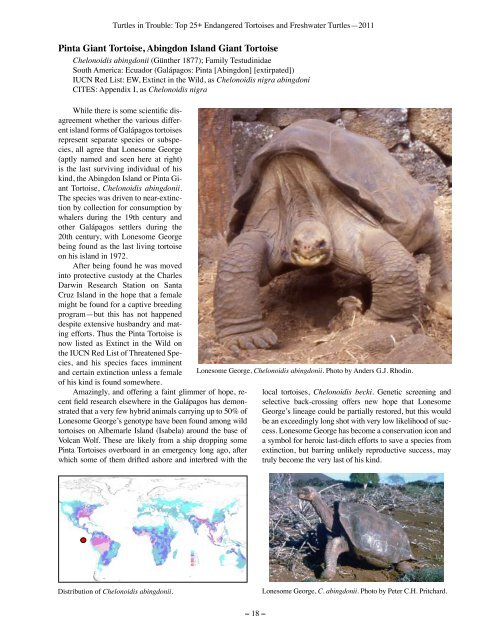<strong>Turtles</strong> <strong>in</strong> <strong>Trouble</strong>: Top <strong>25+</strong> <strong>Endangered</strong> Tortoises and Freshwater <strong>Turtles</strong>—2011P<strong>in</strong>ta Giant Tortoise, Ab<strong>in</strong>gdon Island Giant TortoiseChelonoidis ab<strong>in</strong>gdonii (Günther 1877); Family Testud<strong>in</strong>idaeSouth America: Ecuador (Galápagos: P<strong>in</strong>ta [Ab<strong>in</strong>gdon] [extirpated])IUCN Red List: EW, Ext<strong>in</strong>ct <strong>in</strong> the Wild, as Chelonoidis nigra ab<strong>in</strong>gdoniCITES: Appendix I, as Chelonoidis nigraWhile there is some scientific disagreementwhether the various differentisland forms of Galápagos tortoisesrepresent separate species or subspecies,all agree that Lonesome George(aptly named and seen here at right)is the last surviv<strong>in</strong>g <strong>in</strong>dividual of hisk<strong>in</strong>d, the Ab<strong>in</strong>gdon Island or P<strong>in</strong>ta GiantTortoise, Chelonoidis ab<strong>in</strong>gdonii.<strong>The</strong> species was driven to near-ext<strong>in</strong>ctionby collection for consumption bywhalers dur<strong>in</strong>g the 19th century andother Galápagos settlers dur<strong>in</strong>g the20th century, with Lonesome Georgebe<strong>in</strong>g found as the last liv<strong>in</strong>g tortoiseon his island <strong>in</strong> 1972.After be<strong>in</strong>g found he was moved<strong>in</strong>to protective custody at the CharlesDarw<strong>in</strong> Research Station on SantaCruz Island <strong>in</strong> the hope that a femalemight be found for a captive breed<strong>in</strong>gprogram—but this has not happeneddespite extensive husbandry and mat<strong>in</strong>gefforts. Thus the P<strong>in</strong>ta Tortoise isnow listed as Ext<strong>in</strong>ct <strong>in</strong> the Wild onthe IUCN Red List of Threatened Species,and his species faces imm<strong>in</strong>entand certa<strong>in</strong> ext<strong>in</strong>ction unless a femaleof his k<strong>in</strong>d is found somewhere.Amaz<strong>in</strong>gly, and offer<strong>in</strong>g a fa<strong>in</strong>t glimmer of hope, recentfield research elsewhere <strong>in</strong> the Galápagos has demonstratedthat a very few hybrid animals carry<strong>in</strong>g up to 50% ofLonesome George’s genotype have been found among wildtortoises on Albemarle Island (Isabela) around the base ofVolcan Wolf. <strong>The</strong>se are likely from a ship dropp<strong>in</strong>g someP<strong>in</strong>ta Tortoises overboard <strong>in</strong> an emergency long ago, afterwhich some of them drifted ashore and <strong>in</strong>terbred with theLonesome George, Chelonoidis ab<strong>in</strong>gdonii. Photo by Anders G.J. Rhod<strong>in</strong>.local tortoises, Chelonoidis becki. Genetic screen<strong>in</strong>g andselective back-cross<strong>in</strong>g offers new hope that LonesomeGeorge’s l<strong>in</strong>eage could be partially restored, but this wouldbe an exceed<strong>in</strong>gly long shot with very low likelihood of success.Lonesome George has become a conservation icon anda symbol for heroic last-ditch efforts to save a species fromext<strong>in</strong>ction, but barr<strong>in</strong>g unlikely reproductive success, maytruly become the very last of his k<strong>in</strong>d.Distribution of Chelonoidis ab<strong>in</strong>gdonii.Lonesome George, C. ab<strong>in</strong>gdonii. Photo by Peter C.H. Pritchard.– 18 –
<strong>Turtles</strong> <strong>in</strong> <strong>Trouble</strong>: Top <strong>25+</strong> <strong>Endangered</strong> Tortoises and Freshwater <strong>Turtles</strong>—2011Red River Giant Softshell Turtle, Yangtze Giant Softshell TurtleRafetus sw<strong>in</strong>hoei (Gray 1873); Family TrionychidaeAsia: Ch<strong>in</strong>a (Anhui [?, extirpated?], Jiangsu [?, extirpated?], Yunnan, Zhejiang [?, extirpated?]), VietnamIUCN Red List: CR, Critically <strong>Endangered</strong> A1cd+2cdCITES: Appendix III (Ch<strong>in</strong>a)Rafetus sw<strong>in</strong>hoei is an enormous softshellturtle with shell length over 100 cm that can reach120 kg (250 lbs). Historically this species <strong>in</strong>habitedthe Red River of Yunnan, Ch<strong>in</strong>a, and Vietnam, andpossibly the lower Yangtze River floodpla<strong>in</strong>. Althoughworshipped <strong>in</strong> some areas, capture for consumption,wetland destruction, and water pollutionhave severely impacted its populations. It is hardto believe that such a magnificent creature is almostgone, yet the global population is down to only fourknown rema<strong>in</strong><strong>in</strong>g <strong>in</strong>dividuals. One has lived for decades<strong>in</strong> Hoan Kiem Lake <strong>in</strong> downtown Hanoi whereit is respected and worshipped; another lives <strong>in</strong> a lakewest of Hanoi. Unfortunately, both are males.<strong>The</strong> other rema<strong>in</strong><strong>in</strong>g two animals, a male and afemale, currently reside together <strong>in</strong> the Suzhou Zoo<strong>in</strong> Ch<strong>in</strong>a, after decades of liv<strong>in</strong>g <strong>in</strong> separate facilities<strong>in</strong> Ch<strong>in</strong>a. <strong>The</strong> culm<strong>in</strong>ation of years of work by<strong>Wildlife</strong> Conservation Society Ch<strong>in</strong>a, Turtle Survival Alliance,and Ch<strong>in</strong>ese authorities, with support from the TurtleConservation Fund and other organizations, brought thesetwo animals together <strong>in</strong> 2008. Eggs have been producedeach year s<strong>in</strong>ce, but all have died dur<strong>in</strong>g <strong>in</strong>cubation. Yearsof <strong>in</strong>adequate nutrition and perhaps the advanced age of themale (possibly >100 years) may be contribut<strong>in</strong>g to the lackof successful breed<strong>in</strong>g. With cont<strong>in</strong>uous <strong>in</strong>put from the support<strong>in</strong>gorganizations, numerous husbandry adjustments havebeen made with regard to monitor<strong>in</strong>g nutrition, egg <strong>in</strong>cubation,water quality, and visitor impact. Glass barriers havebeen erected around the breed<strong>in</strong>g pools to prevent public feed<strong>in</strong>gand trash disposal, and the pair can be now be left togetheryear around to improve the chances of a successful breed<strong>in</strong>g.Recent <strong>in</strong>tensive surveys <strong>in</strong> Yunnan, Ch<strong>in</strong>a, showedevidence of R. sw<strong>in</strong>hoei encounters <strong>in</strong> the past twenty years,and one or a few more <strong>in</strong>dividuals could still be surviv<strong>in</strong>g<strong>in</strong> the wild. In Vietnam, the Asian Turtle Conservation Networkhas worked tirelessly over the past decade to surveyLast known wild R. sw<strong>in</strong>hoei, nr. Hanoi, Vietnam. Photo by Tim McCormack.suitable wetlands for surviv<strong>in</strong>g wild <strong>in</strong>dividuals (and foundthe fourth known animal as a result), and is work<strong>in</strong>g with localcommunities and authorities on turtle conservation awareness.This work was rewarded when the wetland west of Hanoibroke its dam last year and the turtle was caught about 10km downriver; the exist<strong>in</strong>g awareness enabled the turtle to beretrieved from the fisherman and released <strong>in</strong>to its (repaired)wetland unharmed. Had the awareness campaign not beensuccessful this animal would have ended up <strong>in</strong> a soup pot.Priority actions for the species <strong>in</strong>clude cont<strong>in</strong>u<strong>in</strong>g towork with Suzhou Zoo towards successful reproduction andeventually develop<strong>in</strong>g a re<strong>in</strong>troduction program for the species.This may <strong>in</strong>clude br<strong>in</strong>g<strong>in</strong>g <strong>in</strong> one of the other, potentiallyyounger males. In addition, it is essential to cont<strong>in</strong>ue surveysand awareness work <strong>in</strong> Yunnan and northern Vietnamwhere possibly another <strong>in</strong>dividual could be located <strong>in</strong> thewild and possibly brought together with the last known wildanimal. Awareness and cont<strong>in</strong>ued local vigilance is neededon behalf of the last wild <strong>in</strong>dividual.Distribution of Rafetus sw<strong>in</strong>hoei.Female R. sw<strong>in</strong>hoei, <strong>in</strong> Suzhou Zoo. Photo by Gerald Kuchl<strong>in</strong>g.– 19 –







![RaLand / SeaScape [PDF] - Wildlife Conservation Society](https://img.yumpu.com/49974326/1/190x245/raland-seascape-pdf-wildlife-conservation-society.jpg?quality=85)








